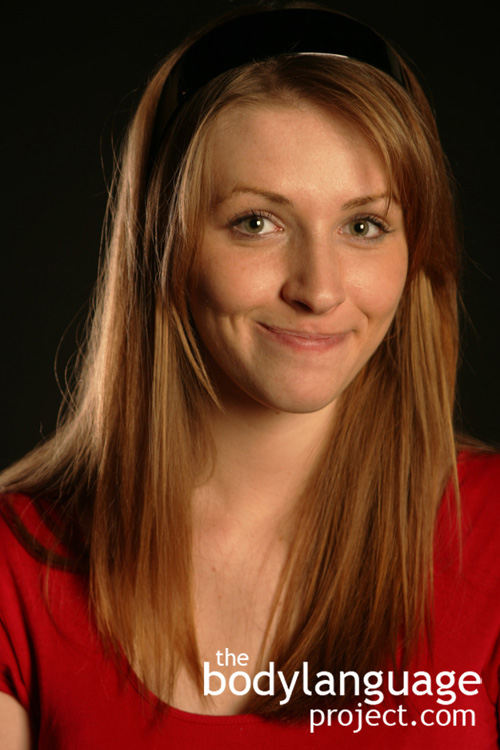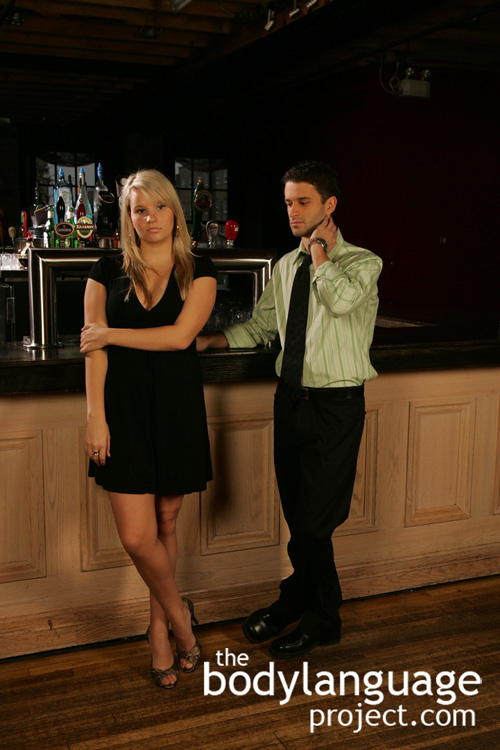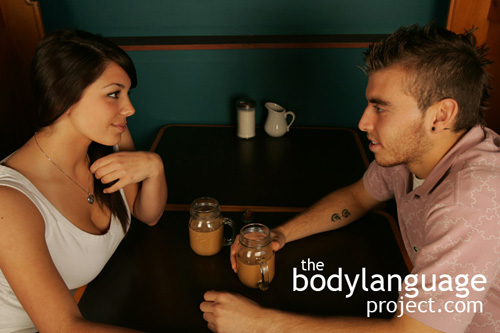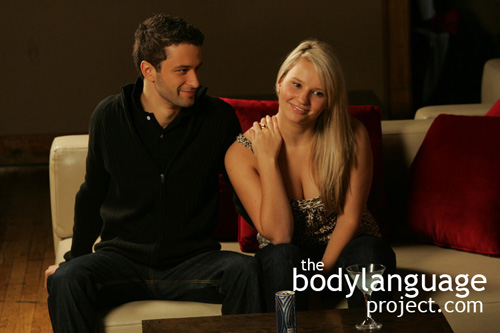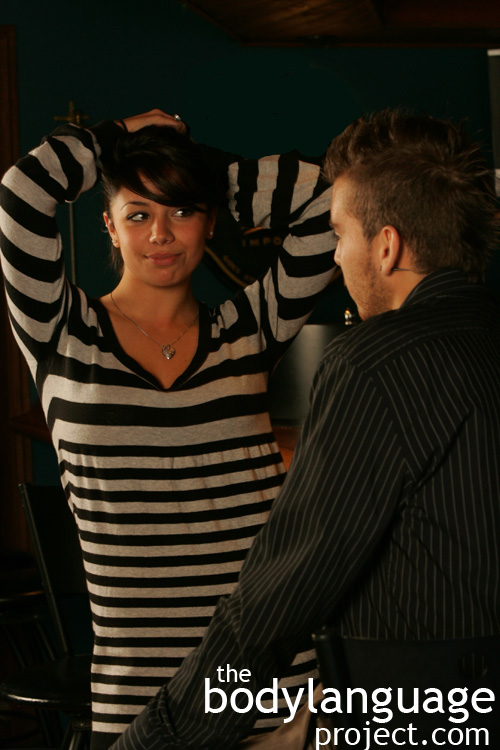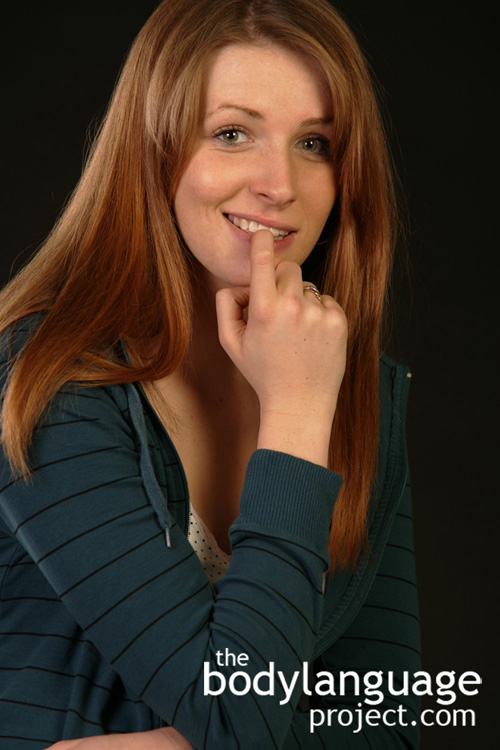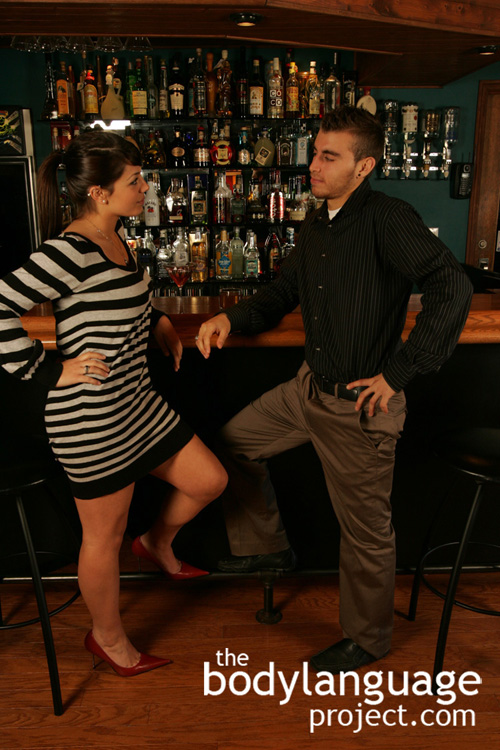Body Language of Military Man or Regal Stance
 Cue: Military Man or Regal Stance
Cue: Military Man or Regal Stance
Synonym(s): Arms Behind The Back Posture, Regal Stance.
Description: It is a standing posture that occurs by placing the hands, palm in palm behind the back.
In One Sentence: The military man stance is a way to demonstrate high authority and confidence.
How To Use it: The military man stance is reserved for high ranking individuals so needs to be used with care. High school principles, those actually in the military, royalty, bosses, presidents, and so forth can show that they lack fear of confrontation. Use the posture to demonstrate, not that you wish to gain power, but that you have already achieved it.
The cue is risky in lower ranking people as it may be viewed as a bluff and backfire inviting attack.
Context: General.
Verbal Translation: “I’m exposing my chest and chin to attack by putting my hands behind my body where they can not serve me. However, in so doing, I warn you – don’t come near me, I’m important and I shouldn’t be touched!”
Variant: The hand gripping the wrist or upper arm in behind the back sends an emotional message of frustration and an attempt at self control, but forms no part of what is said by the military man. See Hand Gripping Upper Arm or Wrist Behind Back.
Cue In Action: The Queen of England and Prince Philip were noted to carry this body language due to their high rank and importance as they greeted large crowds.
Meaning and/or Motivation: Arms behind the back posture signifies a desire not to be touched and a haughty attitude. It is a posture normally held by dominant individuals and leaders who expect no challenge to their authority whatsoever. Royalty, those in the military, high school principals, lawyers, doctors, policemen, and those of high rank will be seen performing this stance.
Power is the main meaning delivered by the military man posture, as it exposes the full front of the body to possible attack and also says that a person is so powerful they aren’t to be touched or approached. Evolutionarily speaking, the military man is a strutting posture. By design, it preemptively avoids potentially harmful physical show-downs between rival men.
Other possible root origins stem from its concealment properties. In other words, a spear, knife or other makeshift sharp object might be cocked, ready to be sprung on unsuspecting challengers – you’d never know, so why risk it!
Cue Cluster: The military man posture is accompanied by holding the chin up and head held back. Usually the feet of the military man are splayed outward so as to take up more space and produce an aura of dominance. The opposite of which is “tibial torsion” when the toes point inward to signal submission.
Body Language Category: Authoritative body language, Confident body language, Dominant body language, High confidence body language, Open body language, Ventral displays.
Resources:
Adams, E.S., Mesterton-Gibbons, M., 1995. The cost of threat displays and the stability of deceptive communication. J. Theor. Biol. 175, 405–421.
Allen, Jill; Sarah J. Gervais and Jessi L. Smith. Sit Big to Eat Big: The Interaction of Body Posture and Body Concern on Restrained Eating. Psychology of Women Quarterly 2013. 37(3): 325-336. DOI: 10.1177/0361684313476477pwq.sagepub.com
http://bodylanguageproject.com/articles/sit-big-to-eat-big-how-constrictive-postures-reduce-food-consumption/
Arnette, S. L., & Pettijohn, T. F., II. (2012). The effects of posture on self-perceived leadership. International Journal of Business and Social Science, 3, 8–13.
Bohns, Vanessa K. and Scott S. Wiltermuth. It Hurts When I Do This (Or You Do That): Posture And Pain tolerance. Journal of Experimental Social Psychology. 2012. 48: 341-345.
http://bodylanguageproject.com/articles/dominant-and-submissive-postures-affects-more-than-public-perception-it-also-affects-felt-pain-and-physical-strength/
Briñol, P., Petty, R. E., & Wagner, B. (2009). Body posture effects on self-evaluation: A self-validation approach. European Journal of Social Psychology, 39, 1053–1064.
Blidstein, Gerald J. The Nonverbal Language of Prayer (review).Shofar: An Interdisciplinary Journal of Jewish Studies. 2007 25(2): 195-196.
Boyson, A. R., Pryor, B., & Butler, J. (1999). Height as power in women. North American Journal of Psychology, 1, 109–114.
Burgoon, J. K., & Hoobler, G. (2002). Nonverbal signals. In M. L. Knapp & J. A. Daly (Eds.), Handbook of interpersonal communication (3rd ed., pp. 240–299). Thousand Oaks, CA: Sage.
Burgoon, J. K., Johnson, M. L., & Koch, P. T. (1998). The nature and measurement of interpersonal dominance. Communication Monographs, 65, 308–335.
Bartholomewn, Morgan E.; Sheri L. Johnson. Nonverbal Dominance Behavior Among Individuals at Risk for Mania. Journal of Affective Disorders. 2014. 159: 133-138.
Bohns, Vanessa K. and Scott S. Wiltermuth. It Hurts When I Do This (Or You Do That): Posture And Pain tolerance. Journal of Experimental Social Psychology. 2012. 48: 341-345.
http://bodylanguageproject.com/articles/dominant-and-submissive-postures-affects-more-than-public-perception-it-also-affects-felt-pain-and-physical-strength/
Bertamini, Marco ; Byrne, Christopher ; Bennett, Kate M. Attractiveness is influenced by the relationship between postures of the viewer and the viewed person. i-Perception. 2013. 4(3): 170-179.
Bjorkqvist, K., Osterrnan, K. and Lagerspetz, K.M.I. (1994) ‘Sex Differences in Covert Aggression among Adults’, Aggressive Behaviour 20: 27–33.
Cannon, W. B. (1929). Bodily changes in pain, hunger, fear and rage (2nd ed.). New York: Appleton, Century, Crofts.
Cashdan, Elizabeth. Smiles, Speech, and Body Posture: How Women and Men Display Sociometric Status and Power. Journal of Nonverbal Behavior. 1998. 22(4): 209-228.
Carney, Dana R.; Amy J.C. Cuddy; Andy J. Yap. Power Posing: Brief Nonverbal Displays Affect Neuroendocrine Levels and Risk Tolerance. Psychological Science, 2010; 21 (10): 1363-1368.
http://bodylanguageproject.com/articles/benefits-power-posing-high-stakes-performance/
Cesario, J., & McDonald, M. M. (2013). Bodies in context: Power poses as a computation of action possibility. Social Cognition, 31, 260–274.
Cuddy, Amy J.C., Caroline A. Wilmuth, and Dana R. Carney. The Benefit of Power Posing Before a High-Stakes Social Evaluation. Harvard Business School Working Paper, No. 13-027, September 2012.
http://bodylanguageproject.com/articles/benefits-power-posing-high-stakes-performance/
Carney, D. R., Hall, J. A., & LeBeau, L. S. (2005). Beliefs about the nonverbal expression of social power. Journal of Nonverbal Behavior, 29, 105–123.
Cuddy, Amy J.C., Caroline A. Wilmuth, and Dana R. Carney. The Benefit of Power Posing Before a High-Stakes Social Evaluation. Harvard Business School Working Paper, No. 13-027, September 2012.
Dunn, Cynthia Dickel. Speaking politely, kindly, and beautifully: ideologies of politeness in Japanese business etiquette training. Multilingua: Journal of Cross-Cultural and Interlanguage Communication. 2013. 32(2): 225(21).
de Lemus, Soledad; Russell Spears and and Miguel Moya. The Power of a Smile to Move You: Complementary Submissiveness in Women’s Posture as a Function of Gender Salience and Facial Expression. Personality and Social Psychology Bulletin. 2012. 38(11): 1480-1494.
Enquist, M. (1985). Communication during aggressive interactions with particular reference to variation in choice of behaviors. Anim. Behav. 33, 1152-1161.
Ellis, L. (1994). The high and the mighty among man and beast: How universal is the relationship between height (or body size) and social status? In L. Ellis (Ed.). Social stratification and socioeconomic inequality (Vol. 2, pp. 93–111). Westport, CT: Praeger Publishers.
Freedman, Norbert ; Blass, Thomas ; Rifkin, Arthur ; Quitkin, Frederic Lanzetta, John T. (editor). Body movements and the verbal encoding of aggressive affect. Journal of Personality and Social Psychology. 1973. 26(1): 72-85.
Fischer, Julia; Peter Fischer; Birte Englich; Nilüfer Aydin and Dieter Frey. Empower My Decisions: The Effects of Power Gestures on Confirmatory Information Processing. Journal of Experimental Social Psychology. 2011. 47: 1146-1154.
http://bodylanguageproject.com/articles/downside-power-posing-body-language-looking-power-posing-action-study/
http://bodylanguageproject.com/articles/benefits-power-posing-high-stakes-performance/
Ginsburg, Harvey J. ; Pollman, Vicki A. ; Wauson, Mitzi S. Odom, Richard D. (editor). An ethological analysis of nonverbal inhibitors of aggressive behavior in male elementary school children. Developmental Psychology. 1977 13(4): 417-418.
Gorkan Ahmetoglu, Viren Swami. Do Women Prefer “Nice Guys?” The Effect Of Male Dominance Behavior On Women’s Ratings. Social Behavior And Personality, 2012; 40(4), 667-672.
http://bodylanguageproject.com/articles/how-to-significantly-increase-male-attractiveness-with-simple-body-language-nice-guys-finish-last-once-again/
Hines, N.J. and Fry, D.P. (1994) ‘Indirect Modes of Aggression among Women of Buenos Aires, Argentina’, Sex Roles 30: 213–24.
Huang, L., Galinsky, A. D., Gruenfeld, D. H., & Guillory, L. E. (2011). Powerful postures versus powerful roles: Which is the proximate correlate of thought and behavior? Psychological Science, 22, 95–102.
Hall, Judith ; LeBeau, Lavonia ; Reinoso, Jeannette ; Thayer, Frank. Status, Gender, and Nonverbal Behavior in Candid and Posed Photographs: A Study of Conversations Between University Employees. Sex Roles. 2001 44(11): 677-692.
Hall, Judith ; LeBeau, Lavonia ; Reinoso, Jeannette ; Thayer, Frank. Status, Gender, and Nonverbal Behavior in Candid and Posed Photographs: A Study of Conversations Between University Employees. Sex Roles. 2001 44(11): 677-692.
Jacob, Heike ; Kreifelts, Benjamin ; Brück, Carolin ; Erb, Michael ; Hösl, Franziska ; Wildgruber, Dirk. Cerebral integration of verbal and nonverbal emotional cues: Impact of individual nonverbal dominance. NeuroImage. 2012. 61(3): 738-747.
Kret M, Pichon S, Grezes J, de Gelder B. Similarities and differences in perceiving threat from dynamic faces and bodies. An fMRI study. NeuroImage 2011;54:1755–62.
Keogh E. Gender differences in the nonverbal communication of pain: A new direction for sex, gender, and pain research? PAIN_ 2014;155:1927–31.
Kret M, Pichon S, Grezes J, de Gelder B. Similarities and differences in perceiving threat from dynamic faces and bodies. An fMRI study. NeuroImage 2011;54:1755–62.
Laird, J. D., & Lacasse, K. (2014). Bodily influences on emotional feelings: Accumulating evidence and extensions of William James’s theory of emotion. Emotion Review, 6, 27–34.
Lagerspetz, K.M.J., Bjorkqvist, K. and Peltonen, T. (1988) ‘Is Indirect Aggression Typical of Females? Gender Differences in Aggressiveness in 11- to 12-year-old Children’, Aggressive Behavior 14: 403–14.
Lee, E. H., & Schnall, S. (2014). The influence of social power on weight perception. Journal of Experimental Psychology: General, 143, 1719–1725.
Locke, Connson C. and Cameron Anderson. The Downside of Looking Like a Leader: Leader’s Powerful Demeanor Stifles Follower Voice in Participative Decision-Making.. Academy of Management Annual Meeting Proceedings. 2010. 8(1): 1-6.
http://bodylanguageproject.com/articles/power-body-language-goes-far/
Li Huang, Adam D. Galinsky, Deborah H Gruenfeld and Lucia E. Guillory. Powerful Postures Versus Powerful Roles: Which Is the Proximate Correlate of Thought and Behavior? 2011, Psychological Science; 22(1): 95–102.
http://bodylanguageproject.com/articles/whats-more-powerful-nonverbal-power-or-real-power/
Mcgurk, Barry J. ; Davis, John D. ; Grehan, John. Assaultive behavior personality and personal space. Aggressive Behavior. 1981. 7(4): 317-324.
Maestripieri, Dario ; Schino, Gabriele ; Aureli, Filippo ; Troisi, Alfonso. A modest proposal: displacement activities as an indicator of emotions in primates. Animal Behaviour, 1992, Vol.44(5), pp.967-979
Mignault, Alain and Chaudhuri, Avi. The Many Faces of a Neutral Face: Head Tilt and Perception of Dominance and Emotion. Journal of Nonverbal Behavior. 2003 27(2): 111-132.
Mondloch, Catherine J. Sad or Fearful? The Influence of Body Posture on Adults’ and Children’s Perception of Facial Displays of Emotion. Journal of Experimental Child Psychology. 2012. 111(2): 180-196.
Meier, B. P., Hauser, D. J., Robinson, M. D., Friesen, C. K., & Schjeldahl, K. (2007b). What’s ‘up’ with God?: Vertical space as a representation of the divine. Journal of Personality and Social Psychology, 93, 699–710.
Meier, B. P., & Robinson, M. D. (2004). Why the sunny side is up: Associations between affect and vertical position. Psychological Science, 15, 243–247.
Meier, B. P., & Robinson, M. D. (2005). The metaphorical representation of affect. Metaphor and Symbol, 21, 239–257.
Melamed, T. (1992). Personality correlates of physical height. Personality and Individual Differences, 13, 1349–1350.
Middleton, W. C., &Moffett, D. C. (1940). The relation of height and weight measurements to intelligence and to dominance-submission among a group of college freshmen. Research Quarterly of the American Association for Health, Physical Education, and Recreation, 11, 53–59.
Montepare, J. M. (1995). The impact of variations in height on young children’s impressions of men and women. Journal of Nonverbal Behavior, 19, 31–47.
Meier, B.P., Robinson, M.D., & Caven, A.J. (in press). Why a big mac is a good mac: Associations between affect and size. Basic and Applied Social Psychology.
Matsumura, Shuichi ; Hayden, Thomas J. When should signals of submission be given?–A game theory model. Journal of Theoretical Biology. 2006. 240(3): 425-433.
Mehrabian, Albert Holzberg, Jules D. (editor). Inference of Attitudes From the Posture, Orientation and Distance of a Communicator. Journal of Consulting and Clinical Psychology. 1968. 32(3): 296-308.
Mehrabian, Albert Deese, James (editor). Significance of posture and position in the communication of attitude and status relationships. Psychological Bulletin. 1969. 71(5): 359-372.
Matsumoto, D., & Willingham, B. (2006). The thrill of victory and the agony of defeat: Spontaneous expressions of medal winners of the 2004 Athens Olympic Games. Journal of Personality and Social Psychology, 91(3), 568–581.
Mouterde, S. C., Duganzich, D. M., Molles, L. E., Helps, S., Helps, R., & Waas, J. R. (2012). Triumph displays inform eavesdropping little blue penguins of new dominance asymmetries. Animal Behaviour, 83, 605–611.
Michalak, J., Mischnat, J., & Teismann, T. (2014). Sitting posture makes a difference: Embodiment effects on depressive memory bias. Clinical Psychology & Psychotherapy, 21, 519–524.
Minvaleev, R. S., Nozdrachev, A. D., Kir’yanova, V. V., & Ivanov, A. I. (2004). Postural influences on the hormone level in healthy subjects: I. The cobra posture and steroid hormones. Human Physiology, 30, 452–456.
Nair, S., Sagar, M., Sollers, J., III, Consedine, N., & Broadbent, E. (2014). Do slumped and upright postures affect stress responses? A randomized trial. Health Psychology. Advance online publication. doi:10.1037/hea0000146
Nadler, Ronald. Sexual initiation in wild mountain gorillas. International Journal of Primatology. 1989. 10(2): 81-92.
Ostrowsky, Michael K. Are violent people more likely to have low self-esteem or high self-esteem? Aggression and Violent Behavior. 2010. 15(1): 69-75.
Pailing, Andrea ; Boon, Julian ; Egan, Vincent. Personality, the Dark Triad and violence Personality and Individual Differences. 2014. 67: 81-86.
Parker, G. A. (1974). Assessment strategy and the evolution of fighting behaviour. J. Theor. Biol. 47, 223-243.
Pitterman, Hallee ; Nowicki Jr, Stephen. A Test of the Ability to Identify Emotion in Human Standing and Sitting Postures: The Diagnostic Analysis of Nonverbal Accuracy-2 Posture Test (DANVA2-POS). Genetic, Social, and General Psychology Monographs. 2004. 130(2): 146-162.
Prieto, A. G., & Robbins, M. C. (1975). Perceptions of height and self-esteem. Perceptual and Motor Skills, 40, 395–398.
Park, Lora E.; Lindsey Streamer; Li Huang and Adam D. Galinsky. Stand Tall, But Don’t Put Your Feet Up: Universal and Culturally-Specific Effects of Expansive Postures On Power. Journal of Experimental Social Psychology. 2013; 49: 965–971.
http://bodylanguageproject.com/articles/are-expansive-postures-of-power-universal-or-cultural/
Park, Lora E.; Lindsey Streamer; Li Huang and Adam D. Galinsky. Stand Tall, But Don’t Put Your Feet Up: Universal and Culturally-Specific Effects of Expansive Postures On Power. Journal of Experimental Social Psychology. 2013; 49: 965–971.
http://bodylanguageproject.com/articles/are-expansive-postures-of-power-universal-or-cultural/
Riskind, J. H. (1984). They stoop to conquer: Guiding and selfregulatory functions of physical posture after success and failure. Journal of Personality and Social Psychology, 47, 479–493.
Riskind, J. H., & Gotay, C. C. (1982). Physical posture: Could it have regulatory or feedback effects on motivation and emotion? Motivation and Emotion, 6, 273–298.
Rule, Nicholas, O.; Reginald B. Adams Jr.; Nalini Ambady and Jonathan B. Freeman. Perceptions Of Dominance Following Glimpses Of Faces And Bodies. Perception. 2012; 41: 687-706 doi:10.1068/p7023
http://bodylanguageproject.com/articles/people-can-read-dominance-split-second
Ranehill, Eva; Anna Dreber; Magnus Johannesson; Susanne Leiberg; Sunhae Sul and Roberto A. Weber. Assessing the Robustness of Power Posing: No Effect on Hormones and Risk Tolerance in a Large Sample of Men and Women. Psychological Science, March, 2015. doi: 10.1177/0956797614553946 http://bodylanguageproject.com/articles/power-posing-no-effect-hormones-amy-cuddy-wrong/
Robinson, Michael D. ; Zabelina, Darya L. ; Ode, Scott ; Moeller, Sara K. The vertical nature of dominance-submission: Individual differences in vertical attention. Journal of Research in Personality. 2008. 42(4): 933-948.
Riskind, John H. Manis, Melvin (editor). They stoop to conquer: Guiding and self-regulatory functions of physical posture after success and failure. Journal of Personality and Social Psychology. 1984 47(3): 479-493.
Roberts, Tomi-Ann and Yousef Arefi-Afshar. Not All Who Stand Tall Are Proud: Gender Differences in the Proprioceptive Effects of Upright Posture. Cognition and Emtion. 2007. 21(4):714-727.
http://bodylanguageproject.com/articles/do-women-benefit-from-power-posing-study-suggests-not/
Schubert, T. W. (2005). Your highness: Vertical positions as perceptual symbols of power. Journal of Personality and Social Psychology, 89, 1–21.
Simon D, Craig K, Gosselin F, Belin P, Rainville P. Recognition and discrimination of prototypical dynamic expressions of pain and emotions. PAIN_ 2008;135:55–64.
Schwartz, B., Tesser, A., & Powell, E. (1982). Dominance cues in nonverbal behavior. Social Psychology Quarterly, 45, 114–120.
Stepper, S., & Strack, F. (1993). Proprioceptive determinants of emotional and nonemotional feelings. Journal of Personality and Social Psychology, 64, 211–220.
Schenkel, Rudolf. Submission: Its Features and Function in the Wolf and Dog. American Zoologist. 1967. 7(2): 319-329.
Szalai, F. and Szamado, S. (2009). Honest and cheating strategies in a simple model of aggressive communication. Anim. Behav. 78, 949-959.
Sturman, Edward D. Invluntary Subordination and Its Relation to Personality, Mood,
and Submissive Behavior. Psychological Assessment. 2011. 23(1): 262-276 DOI: 10.1037/a0021499
http://bodylanguageproject.com/articles/nonverbal-submission-men-women-depression-critical-examination-use-disuse-submission/
Stanton, Steven J. and Robin S. Edelstein. The Physiology of Women’s Power Motive: Implicit Power Motivation is Positively Associated With Estradiol Levels in Women. Journal of Research in Personality. 2009. 43: 1109-1113.
http://bodylanguageproject.com/articles/the-estrogen-factor-the-search-for-nonverbal-power-in-women/
Stanton, Steven J. The Essential Implications of Gender in Human Behavioral Endocrinology Studies. Frontiers in Behavioral Neuroscience. 2011. 5(9): 1-3. doi: 10.3389/fnbeh.2011.00009
http://bodylanguageproject.com/articles/a-critical-commentary-on-amy-cuddys-power-posing/
Stepper, S., & Strack, F. (1993). Proprioceptive determinants of emotional and nonemotional feelings. Journal of Personality and Social Psychology, 64, 211–220.
Strelan, P., Weick, M., & Vasiljevic, M. (2013). Power and revenge. British Journal of Social Psychology, 53, 521–540.
Szamado, S. (2008). How threat displays work: species-specific fighting techniques, weaponry and proximity risk. Anim. Behav. 76, 1455-1463.
Schubert, Thomas W. and Koole, Sander L. The embodied self: Effects of making a fist on the implicit and explicit self-concept of men and women. Journal of Experimental Social Psychology. 2009. 45: 828-834.
Schwartz, Barry ; Tesser, Abraham ; Powell, Evan. Dominance Cues in Nonverbal Behavior. Social Psychology Quarterly. 1982. 45(2): 114-120.
Schubert, T. W. (2005). Your highness: Vertical positions as perceptual symbols of power. Journal of Personality and Social Psychology. 89, 1–21.
Topel, Eva-Maria ; Lachmann, Frankm. Nonverbal Dialogues: Orienting and Looking Behaviors Between Aggressive and Violent Children and Adolescents and Their Therapist. Journal of Infant, Child, and Adolescent Psychotherapy. 2007. 6(4): 285-307.
Tiedens, Larissa Z. and Alison R. Fragale. Power Moves: Complementarity in Dominant and Submissive Nonverbal Behavior. Journal of Personality and Social Psychology. 2003, 84(3): 558–568.
http://bodylanguageproject.com/articles/power-posing-no-effect-hormones-amy-cuddy-wrong/
Tiedens, Larissa Z ; Fragale, Alison R. Power moves: complementarity in dominant and submissive nonverbal behavior. Journal of personality and social psychology. 2003. 84(3): 558-68.
Tracy, J. L., & Matsumoto, D. (2008). The spontaneous expression of pride and shame: Evidence for biologically innate nonverbal displays. Proceedings from the National Academy of Sciences, 105(33), 11655–11660.
Tracy, J. L., & Robins, R. W. (2007). The prototypical pride expression: Development of a nonverbal behavior coding system. Emotion, 7(4), 789–801.
Tracy, J. L., & Robins, R. W. (2004). Show your pride: Evidence for a discrete emotion expression. Psychological Science, 15, 194–197.
Underwood, M. K.. Glares of Contempt, Eye Rolls of Disgust and Turning Away to Exclude: Non-Verbal Forms of Social Aggression among Girls. Feminism & Psychology. 2004 14(3): 371-375
Welker, Keith M. ; Oberleitner, David E. ; Cain, Samantha ; Carré, Justin M. Upright and left out: Posture moderates the effects of social exclusion on mood and threats to basic needs. European Journal of Social Psychology. 2013 43(5): 355-361.
Walsh, Joseph ; Eccleston, Christopher ; Keogh, Edmund. Pain communication through body posture: The development and validation of a stimulus set. Pain. 2014 155(11): 2282-2290.
Walsh, Joseph ; Eccleston, Christopher ; Keogh, Edmund. Pain communication through body posture: The development and validation of a stimulus set. Pain. 2014. 155(11): 2282-2290.
Yap, Andy J.; Abbie S. Wazlawek, Brian J. Lucas, Amy J. C. Cuddy, Dana R. Carney. The Ergonomics of Dishonesty: The Effect of Incidental Posture on Stealing, Cheating, and Traffic Violations, 24(11); 2281-2289.
http://bodylanguageproject.com/articles/body-posture-physical-environment-determine-feelings-and-behaviour-study/
Yamagiwa, Juichi. Activity rhythm and the ranging of a solitary male mountain gorilla (Gorilla gorilla beringei). Primates, 1986, Vol.27(3), pp.273-282.


